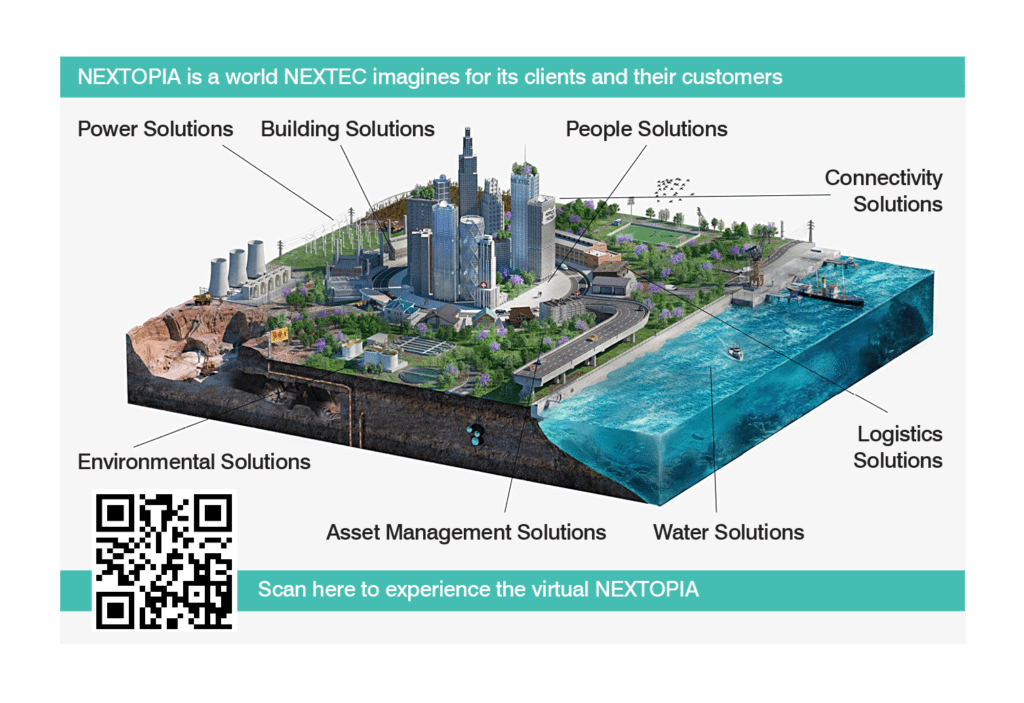Sustainable growth hinges on the ability to optimise resources and the infrastructure backbone that serves communities and economies. Sean Bennett, Group Executive at NEXTEC (a proudly EOH company), expands on the Group’s smart technologies and engineering solutions.
One of most significant milestones in modern history was the unveiling of the world’s first programmable digital computer in 1945, coined ENIAC. Although basic in today’s terms, it represented a major leap forward for digitalisation and the power of interconnectivity via the internet of things (IoT). “The path of change is now constant, so staying ahead of the IoT curve is essential to remain competitive and relevant as smart technologies continue to positively transform society,” Bennett explains. Within South Africa, NEXTEC’s digital transformation thrust is spearheaded by its Infrastructure Solutions and People Solutions platforms. The Infrastructure Solutions business line comprises two key service clusters, namely Digital Infrastructure and Infrastructure Consulting. The latter has two main offerings, which include environmental, sustainability and social-impact consulting solutions and multidisciplinary engineering consulting solutions. NEXTEC’s Digital Infrastructure services are designed to seamlessly integrate physical systems with digital technologies to create intelligent, resilient and high-performance systems. Areas that they specialise in include water, power, connectivity, as well as building technology, logistics and asset management. Bennett believes People Solutions, combined with the technology offering, creates a unique proposition allowing clients to move forward into a more technologically enabled age – for example, having the ability within the business to provide solutions that use technology to lower accident rates. In parallel, People Solutions helps clients to respond to the challenges and opportunities presented by digital transformation in terms of recruitment, learnerships, training, and functional client outsourcing of non-core processes. NEXTOPIA “We refer to our holistic services as NEXTOPIA – the connected and increasingly digitalised world we imagine for our clients and their customers,” Bennett explains. “Technology and IoT provide amazing opportunities to raise socio-economic standards through improved service delivery, smart infrastructure and intelligent business processes, which for any country is essential to remain globally competitive,” Bennett continues. Every nation is at a different stage in the digitalisation journey. Cities like Dubai and Singapore are at the cutting-edge of the so-called smart city evolution, spurred on by robust GDP growth, IoT investment and adoption, and a highly advanced education system. South Africa still has some way to go to match this, but it’s a work in progress. The smart city concept enables the capturing of big data to analyse, interpret, predict, manage and model every conceivable process via digital twinning – a virtual rendition of the real world. Within the public sector arena, there are far-reaching benefits for the management and refinement of all social infrastructure and related activities like education and healthcare. “Our business model focuses on providing practical solutions that are scalable, improve operational efficiencies, lower costs and boost profitability, and includes close working relationships with our OEM technology partners. For public sector clients, key deliverables include improved asset utilisation, enhanced asset security and better service delivery,” Bennett expands. Now, thanks to advances in artificial intelligence, the large volumes of data captured via 5G devices can be processed with a high degree of speed and accuracy, translating this information into meaningful reports and tasks.
“We have technology at NEXTEC that allows you to look at the cracks in the pavement, and predict where potholes will arise in six months,” says Bennett. “Identifying a crack in the road through image analysis and machine learning is low-cost, and then allows asset owners to fix cracks before they become potholes, at a fraction of the cost and inconvenience to traffic.”
Award-winning project A recent example of a comprehensive asset management solution is a NEXTEC project working with one of the provincial governments responsible for managing over 2 800 facilities, including schools, hospitals, clinics, office buildings, depots, parks and infrastructure. NEXTEC’s team is developing an Infrastructure Asset Management Framework and Asset Data Model aligned with industry standards and complex technical requirements. The outcome was that communication and governance improved; management was more effective; long-term forecasting could inform strategy, budgeting and resource allocation; and the department was placed in a position where it had better control over outcomes. Smart buildings and warehouses Energy efficiency gains is another focus area – from environmental, demand-side management and cost perspectives – given the recent escalation in electricity tariffs. In this respect, NEXTEC’s building management solutions have been able to pass on significant efficiency gains for clients, with power usage reductions of up to 35%, and a one-to-three-year payback on the initial technology investment. NEXTEC also has a division that specialises in the design of intelligent warehouses and distribution centres. Its approach focuses on driving operational efficiency through the design of optimised process flows and the application of fit-for-purpose, mechanised and automated materials handling systems, overlaid with appropriate IT systems. Further efficiencies are gained through the design of a building and site envelope that supports the internal operations and flows, enabling the distribution operation to achieve its required throughput. Distribution centres today have a key role to play in environmental sustainability and supporting ESG initiatives – which are at the centre of the team’s design approach.
Bennett asserts. Integrated solutions NEXTEC’s services are frequently integrated. A recent example is a large government agency contract secured by NEXTEC for an integrated building management system, digital twinning and security solution. The agency required a holistic solution for its facility – integrating everything from perimeter control to CCTV, access control and alarms – as well as a building management solution that linked IoT and critical assets, including laboratories and data centres, in a utility-efficient manner. NEXTEC’s system design enabled the agency to access a digitised 3D graphical representation of its buildings’ critical systems. As a result, the agency can now proactively monitor, maintain and change conditions on hydraulics, generators, HVAC and laboratories via smart devices. Thinking ahead Thanks to the progressive roll-out of its 5G network, South Africa’s access to data, communications technology and connectivity is now on par with the world’s best. This is further supported by large-scale local investments in data centres. “We have the power of connectively in our hands. Now we need to embrace it to shape South Africa’s future socio-economic landscape in a more coherent and collaborative manner. It’s an exciting mindset shift, and an opportunity to catch up and keep pace with digital trends that promote sustainability,” Bennett concludes.








